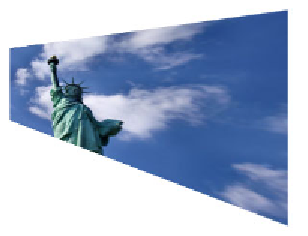Java Reference
In-Depth Information
The first of these effects,
PerspectiveTransform
, gives us a mechanism to ren-
der an artificial 3D effect to content that is otherwise two-dimensional. It is
accomplished by mapping the original content to an arbitrary four-sided polygon
to provide perspective. The instance variables that must be defined represent the
(
x
,
y
) coordinates of the new polygon, namely the upper-left (
ulx
,
uly
), upper-
right (
urx
,
ury
), lower-left (
llx
,
lly
), and lower-right (
lrx
,
lry
) corners. Let's
begin with an image as shown in Figure 6.22.
Figure 6.22
Base Image Before PerspectiveTransform
Let's apply a
PerspectiveTransform
on it, using this code:
ImageView {
image: Image {
url: "{__DIR__}liberty.jpg"
}
effect: PerspectiveTransform {
ulx: 10 uly: 50
urx: 200 ury: 10
llx: 10 lly: 100
lrx: 200 lry: 160
}
}
The resulting image is transformed into the output displayed by Figure 6.23.
Figure 6.23
Base Image After PerspectiveTransform Has Been Applied



Search WWH ::

Custom Search